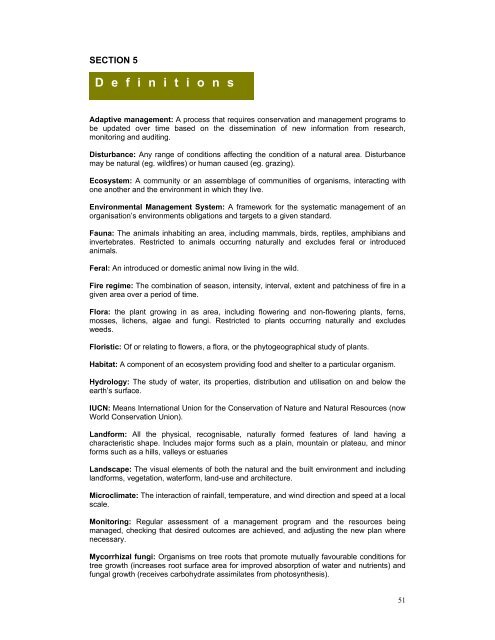DRAFT Tuart Conservation and Management Strategy
DRAFT Tuart Conservation and Management Strategy
DRAFT Tuart Conservation and Management Strategy
You also want an ePaper? Increase the reach of your titles
YUMPU automatically turns print PDFs into web optimized ePapers that Google loves.
SECTION 5<br />
D e f i n i t i o n s<br />
Adaptive management: A process that requires conservation <strong>and</strong> management programs to<br />
be updated over time based on the dissemination of new information from research,<br />
monitoring <strong>and</strong> auditing.<br />
Disturbance: Any range of conditions affecting the condition of a natural area. Disturbance<br />
may be natural (eg. wildfires) or human caused (eg. grazing).<br />
Ecosystem: A community or an assemblage of communities of organisms, interacting with<br />
one another <strong>and</strong> the environment in which they live.<br />
Environmental <strong>Management</strong> System: A framework for the systematic management of an<br />
organisation’s environments obligations <strong>and</strong> targets to a given st<strong>and</strong>ard.<br />
Fauna: The animals inhabiting an area, including mammals, birds, reptiles, amphibians <strong>and</strong><br />
invertebrates. Restricted to animals occurring naturally <strong>and</strong> excludes feral or introduced<br />
animals.<br />
Feral: An introduced or domestic animal now living in the wild.<br />
Fire regime: The combination of season, intensity, interval, extent <strong>and</strong> patchiness of fire in a<br />
given area over a period of time.<br />
Flora: the plant growing in as area, including flowering <strong>and</strong> non-flowering plants, ferns,<br />
mosses, lichens, algae <strong>and</strong> fungi. Restricted to plants occurring naturally <strong>and</strong> excludes<br />
weeds.<br />
Floristic: Of or relating to flowers, a flora, or the phytogeographical study of plants.<br />
Habitat: A component of an ecosystem providing food <strong>and</strong> shelter to a particular organism.<br />
Hydrology: The study of water, its properties, distribution <strong>and</strong> utilisation on <strong>and</strong> below the<br />
earth’s surface.<br />
IUCN: Means International Union for the <strong>Conservation</strong> of Nature <strong>and</strong> Natural Resources (now<br />
World <strong>Conservation</strong> Union).<br />
L<strong>and</strong>form: All the physical, recognisable, naturally formed features of l<strong>and</strong> having a<br />
characteristic shape. Includes major forms such as a plain, mountain or plateau, <strong>and</strong> minor<br />
forms such as a hills, valleys or estuaries<br />
L<strong>and</strong>scape: The visual elements of both the natural <strong>and</strong> the built environment <strong>and</strong> including<br />
l<strong>and</strong>forms, vegetation, waterform, l<strong>and</strong>-use <strong>and</strong> architecture.<br />
Microclimate: The interaction of rainfall, temperature, <strong>and</strong> wind direction <strong>and</strong> speed at a local<br />
scale.<br />
Monitoring: Regular assessment of a management program <strong>and</strong> the resources being<br />
managed, checking that desired outcomes are achieved, <strong>and</strong> adjusting the new plan where<br />
necessary.<br />
Mycorrhizal fungi: Organisms on tree roots that promote mutually favourable conditions for<br />
tree growth (increases root surface area for improved absorption of water <strong>and</strong> nutrients) <strong>and</strong><br />
fungal growth (receives carbohydrate assimilates from photosynthesis).<br />
51

















